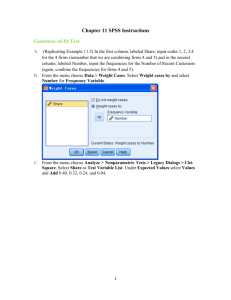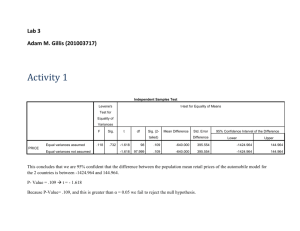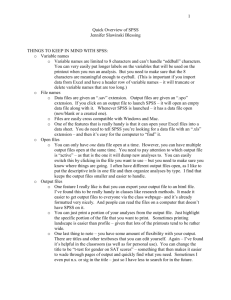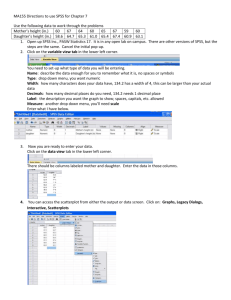Comparing Two Proportions
advertisement
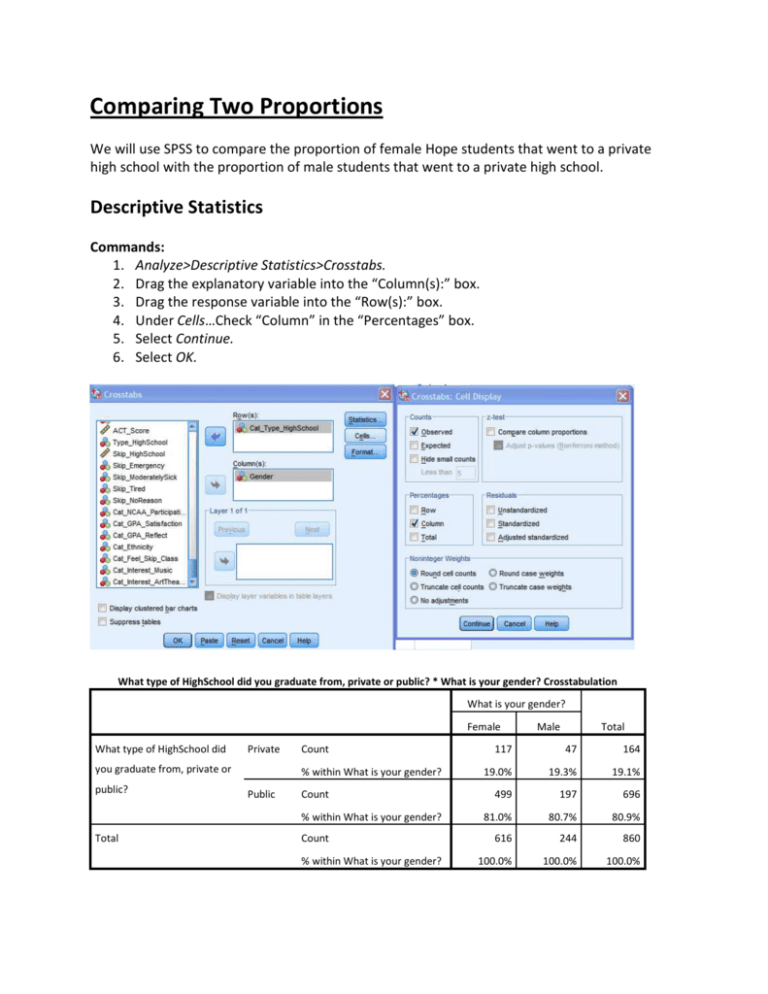
Comparing Two Proportions We will use SPSS to compare the proportion of female Hope students that went to a private high school with the proportion of male students that went to a private high school. Descriptive Statistics Commands: 1. Analyze>Descriptive Statistics>Crosstabs. 2. Drag the explanatory variable into the “Column(s):” box. 3. Drag the response variable into the “Row(s):” box. 4. Under Cells…Check “Column” in the “Percentages” box. 5. Select Continue. 6. Select OK. What type of HighSchool did you graduate from, private or public? * What is your gender? Crosstabulation What is your gender? Female What type of HighSchool did Private you graduate from, private or public? Count % within What is your gender? Public Count % within What is your gender? Total Count % within What is your gender? Male Total 117 47 164 19.0% 19.3% 19.1% 499 197 696 81.0% 80.7% 80.9% 616 244 860 100.0% 100.0% 100.0% Graphs Commands: 1. Graphs>Chart Builder>Bar. 2. Drag the stacked bar to the upper window. 3. Drag the explanatory variable to the “X-Axis” box. 4. Drag the response variable to the “Stack: set color” box. 5. Under Statistic: choose Percentage(). 6. Under Set Parameters… choose Total for Each X-Axis Category. 7. Select Continue. 8. Select Apply. 9. Select OK. Inference Commands: 1. Analyze>Descriptive Statistics>Crosstabs. 2. Drag the explanatory variable into the “Column(s):” box. 3. Drag the response variable into the “Row(s):” box. 4. Under Statistics…Check “Chi-Square.” 5. Select Continue. 6. Select OK. This box gives us the p-value of .928 (shown in red). The p-value is in the “Pearson Chi-Square” row and “Asymp. Sig. (2-sided)” column. Note that it is 2 sided. Chi-Square Tests Value Pearson Chi-Square Continuity Correction Likelihood Ratio Exact Sig. (2- Exact Sig. (1- sided) sided) sided) a 1 .928 .000 1 1.000 .008 1 .928 .008 b df Asymp. Sig. (2- Fisher's Exact Test .924 Linear-by-Linear Association .008 N of Valid Cases 860 1 .928 a. 0 cells (.0%) have expected count less than 5. The minimum expected count is 46.53. b. Computed only for a 2x2 table .499 Applet After you have found descriptive measures, you may take that information and use it in the Theory-based applet. In fact, SPSS does compute confidence intervals for the difference in proportions, so if you want this you should use the applet. Below are the graphs, p-value and confidence interval for our example. Comparing Two Means We will use SPSS to compare the average age of female Hope students with the average age of male Hope students. Descriptive Statistics and Inference Commands: 1. 2. 3. 4. Analyze>Compare Means>Independent-Samples T Test… The “Test Variable” is the response variable (which should be quantitative). The “Grouping Variable” is the explanatory variable (which should be categorical). Define Groups… to indicate to SPSS which two groups are being compared. In the box “Group1,” type in the variable value (as it appears in “Data View”) for the first group (i.e.: “0”). In the box “Group 2,” type in the variable value (as it appears in “Data View”) for the second group (i.e.: “1”). Select Continue. Group Statistics What is your gender? What is your age? N Mean Std. Deviation Std. Error Mean Female 643 20.1213 1.67655 .06612 Male 259 20.2355 1.30982 .08139 Independent Samples Test Levene's Test for Equality of Variances t-test for Equality of Means 95% Confidence Interval of the Sig. F What is Equal .004 Sig. .948 t -.982 df (2- Mean Std. Error tailed) Difference Difference Difference Lower Upper 900 .326 -.11421 .11629 -.34245 .11402 -1.089 604.998 .276 -.11421 .10486 -.32015 .09172 your age? variances assumed Equal variances not assumed In red above are the standardized statistic (t-statisitc), the 2-sided p-value, our observed statistic (the difference in means) and a 95% confidence interval. Note: SPSS will always give the two-sided p-value. To get the one-sided p-value (assuming that the sample mean of Group 1 is larger than Group 2 and the alternative hypothesis is such that the population mean of Group 1 is larger than Group 2), divide the SPSS two-sided p-value in half. Graphs Commands: 1. Graphs>Chart Builder>Boxplot. 2. Drag the simple boxplot to the upper window. 3. Drag the explanatory variable to the “X-Axis” box. 4. Drag the response variable to the “Y-Axis” box. 5. Select OK. Shown here is side-by-side boxplots are shown of ages for males and females. The open circles represent potential outliers that are above the upper quartile + 1.5(IQR) and the asterisks Applet After you have found descriptive measures, you may take that information and use it in the Theory-based applet. If you have your data in SPSS in columns right next to each other, you may also paste that in the applet. Below are the graphs, p-value and confidence interval for our example.
